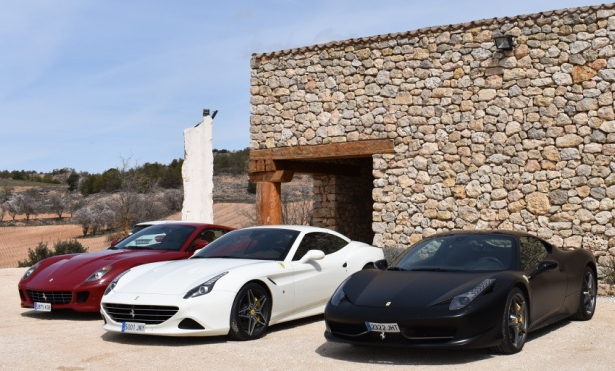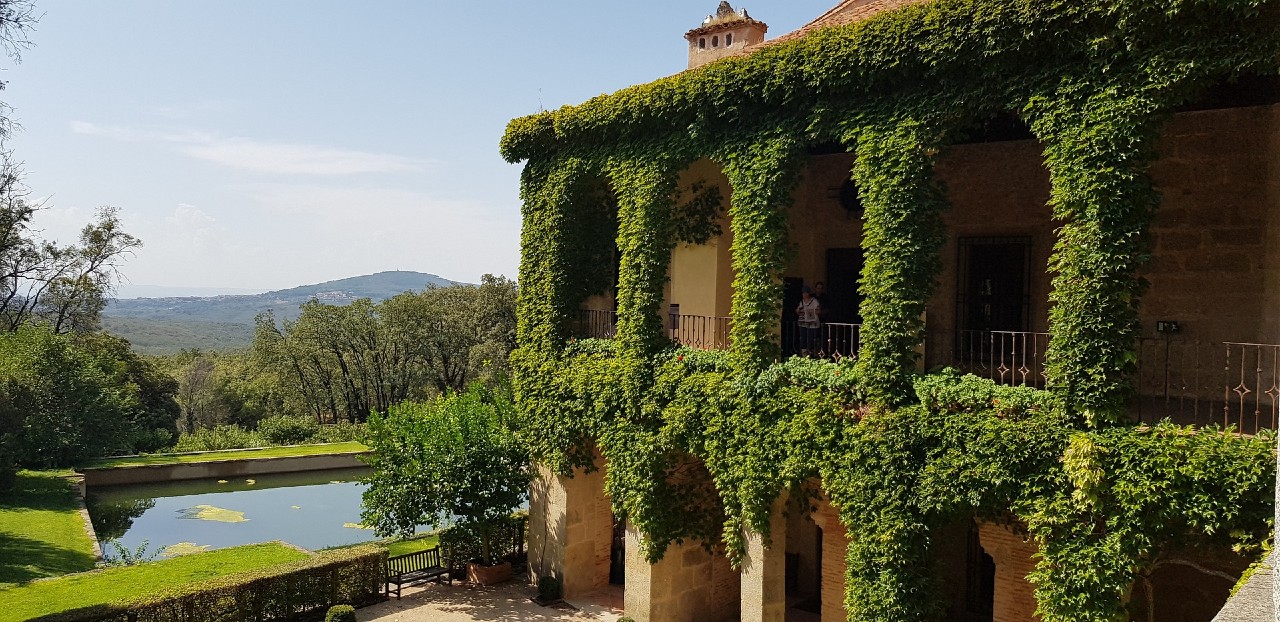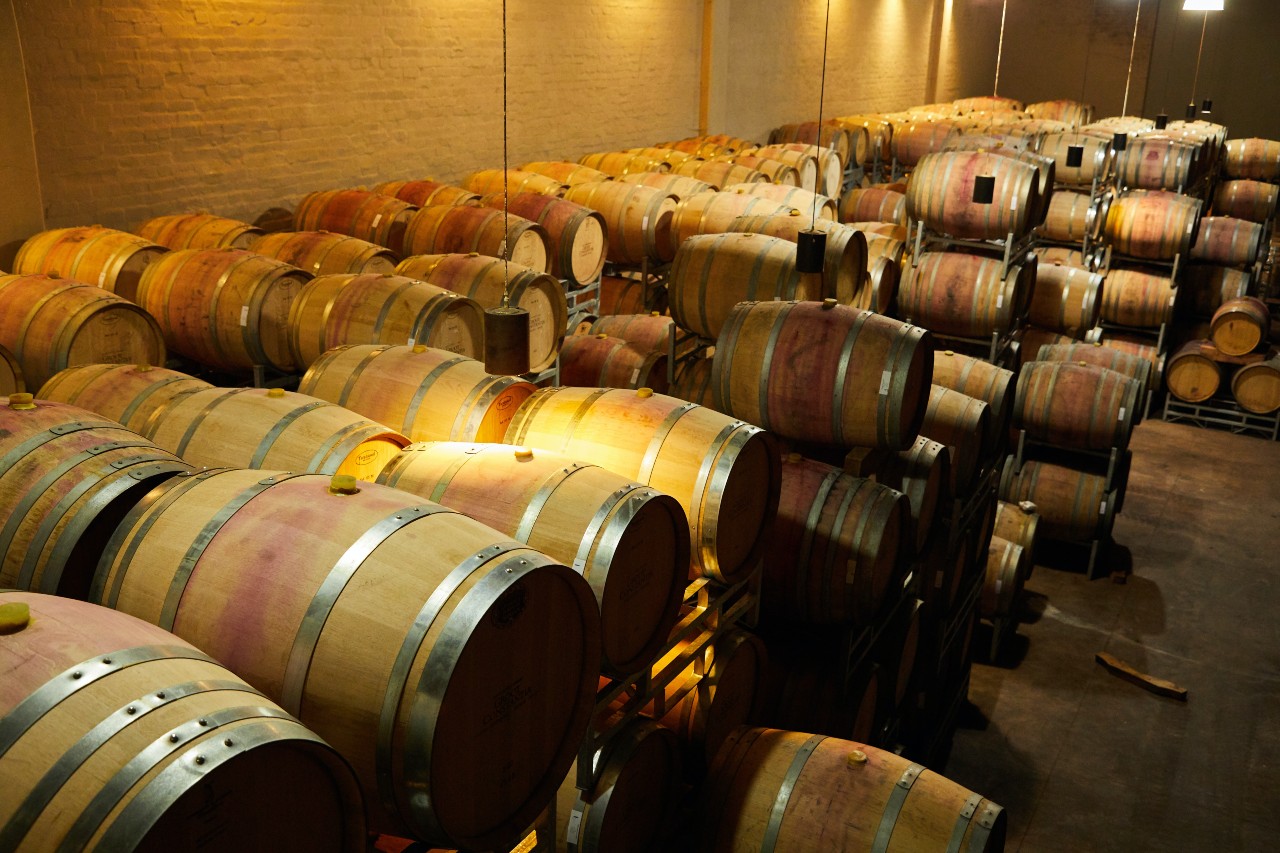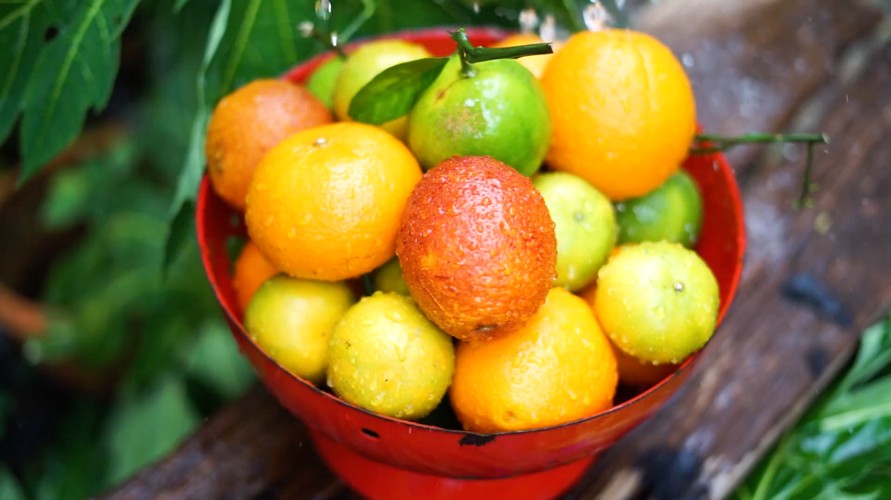“Valduero ‘La Teneda’, the first Spanish international wine social club”.
“Under the leadership of Enzo, Ferrari won more than 5000 races in all categories and obtained 25 World Championship titles”.

Because of my job I have visited many wineries and sincerely Bodegas Valduero has surprised me and I am going to tell you why. Moreover, it has been such a pleasure to visit the winery with a group of friends of Ferrari and enjoy these wonderful, mythical cars. For years, Valduero and Ferrari have been growing together as two great brands of reference in their respective fields: Both are leaders in the luxury sector and arouse passions, highlighting the world of wine Valduero 12 Years and Valduero Lantigua 1989, and the new model of the Italian team, the Ferrari 812 Superfast 2018.
VALDUERO

The Beginning
Valduero is a family run winery and one of the first to be founded in the D.O. Ribera del Duero. It was created in 1984 by Gregorio García Álvarez in the small village Gumiel de Mercado in the Province of Burgos, 16km north east of Aranda del Duero in the heart of the Ribera del Duero. At that time there were only half a dozen bottling wineries and despite being a wine region with a long tradition, known by the cognoscenti for its quality, it was a region unknown by most of the public. These were also the origins of DO Ribera del Duero’s Regulating Council.
Yolanda García Viadero, daughter of the founder and herself an agronomist, discovered at that time the traditional viticulture of the area and the Tinto Fino grape from those vineyards. She describes this grape as “exceptional and unique in Spain, with the distinct character of an exclusive terroir that gives a structure and total acidity to the wines, placing them at the highest levels of quality in the world”.
 This idea is the fundamental basis of the Valduero philosophy, which today has become the norm of the house.
This idea is the fundamental basis of the Valduero philosophy, which today has become the norm of the house.
In Valduero, they have always been clear that the wines must be excellent in every way so as to bring satisfaction and enjoyment to the consumer. That is why the wines are aged and kept in the winery, until they reach roundness and perfect harmony always based on strength. This is why, Valduero has focused on the creation of wines that are Crianza, Reserva and Gran Reserva.
 Yolanda is convinced that a great grape needs time and care to be able to develop and give the best of itself. She considers the time spent in the barrel and in the bottle to be absolutely necessary and takes care of the smallest details that respect what comes from such unique vines.
Yolanda is convinced that a great grape needs time and care to be able to develop and give the best of itself. She considers the time spent in the barrel and in the bottle to be absolutely necessary and takes care of the smallest details that respect what comes from such unique vines.
A 17th-century sandy-walled cellar, more than 30 metres below ground level.
In their beginnings as winemakers in 1984 they spent more than 5 years using some old facilities in the village of Gumiel de Mercado. Along with these facilities they acquired an old ruined wine press in the same village that they restored and then put into operation their 19m deep cellar that dates from the 17th century.
In the cellar they only had space to store 500 barrels so they decided to extend it, reaching almost 1 Km of excavated tunnels more than 30m below the surface , where more than 1,000 barrels used in the aging process of the Reservas and Grandes Reservas: Valduero “6 years” y Valduero “12 years” are now stored.
The deepest point is 40m below ground and this cellar was in its time what today signifies the 1000 m2 tunnel where the barrels are stored.
Extending this cellar took a year under the supervision of D. Gregorio García, President of Valduero and Yolanda García Viadero. They contracted an Asturian specialist who drilled these tunnels with his machine, the mole.
Today they want to preserve the cellar in memory of their ancestors who made wine in the old wine presses.

The winery
In 1987, Yolanda García Viadero joined the winery’s technical management team, followed by Carolina responsible for commercial development. It is at this time that the winery begins its growth. Currently, the business is run by Don Gregorio’s two daughters, who have continuously increased the volume of their production, maintaining maximum quality. From that year onwards, Don Gregorio and his daughters developed the project with a firm step and three solid pillars: own low production vineyard (200 Hectares.), construction of a unique winery by combining the practical and aesthetic sense and the market, with special emphasis on exports.
For the design of the winery they did not turn to a famous architect but relied on their own experience of making quality wine and combined practical needs with an aesthetic based on the architecture of the area. With this simple combination they created the buildings that currently make up the winery. Bodegas Valduero in Ribera del Duero.
The winery was built by excavating three tunnels under a mountain, dedicated respectively to the elaboration in stainless steel tanks, to the storage of barrels and to the bottle rack. Currently, Valduero has over 4,000 oak barrels and a million bottles that rest in the cellar until they reach the optimum point of evolution. It exports its wines to more than 40 countries around the world, with approximately 55% of its total turnover going to them.
The Vineyards
Located in a “Châteaux” style, surrounding the winery, Valduero has 200 hectares of its own goblet vineyards. Through strict pruning, very low yields are achieved in terms of quantity of grapes per vine, thus achieving exceptional quality.
A unique and special vineyard
One of the great concerns of the García Viadero family has always been the quality of the grapes and self-supply. That is why they started to plant 200 hectares of vineyards at the end of the 80s in the exclusive area of Gumiel del Mercado. Without a doubt, it is in this area where the terroir is most characteristic and therefore highlights more intensely the superior qualities of Ribera de Duero compared to other areas of the world.
 Their years of experience have led them to catalogue the Tinto Fino grape as the variety best adapted to the noble and high-profile wines of the Ribera del Duero. This variety is known by other names such as: Tempranillo, Tinta del país, Cencibel.
Their years of experience have led them to catalogue the Tinto Fino grape as the variety best adapted to the noble and high-profile wines of the Ribera del Duero. This variety is known by other names such as: Tempranillo, Tinta del país, Cencibel.
This is the reason why all Valduero wines are mono-varietal. Given the special climatic conditions, the location of the vineyards, the variety of grapes and the quality requirements that the winery family imposes on itself, they decided to preserve the traditional goblet system, in order to limit the production in a natural way (always less than 4,000 kg/ha). Currently, Bodegas Valduero is one of the largest goblet plantations in Spain, something which in my opinion sets it apart from other bodegas in the region. The vineyard is also maintained without irrigation, as with the passing of time they realised that the vines can withstand the extreme climate of the region very well (maximums of 40º in summer and minimums of -17º in winter), as well as the difference in temperatures that can occur on the same day, these are very important factors in ensuring the good quality of the grapes.
Additionally, they have dispensed with all forms of chemical fertilizers, instead they use sheep manure every two years, which provides the soil with the necessary nutrients and salts for optimal vine growth. The soil is extremely poor, very dry and mainly clayey-calcareous in character, with some sandy areas. The landscape is hilly, and there are trees (pines, oaks and holm oaks) and small bushes (lavender, thyme and rosemary, amongst others).
 Due to the altitude of the area (840 metres above sea level), the climate is continental, with harsh winters and frequent frosts (even in the month of May). Although the summer is hot, the nights are cold, resulting in drastic temperature changes that greatly improve the quality of the grapes. These climatic conditions are ideal for the production of long-lasting and powerful wines, as the Tinto Fino grapes mature very slowly and maintain an exceptional balance of strength and acidity during the cycle. All this means that with traditional viticulture, the production per hectare does not exceed 4,000kg/Ha. This ensures that quality increases exponentially.
Due to the altitude of the area (840 metres above sea level), the climate is continental, with harsh winters and frequent frosts (even in the month of May). Although the summer is hot, the nights are cold, resulting in drastic temperature changes that greatly improve the quality of the grapes. These climatic conditions are ideal for the production of long-lasting and powerful wines, as the Tinto Fino grapes mature very slowly and maintain an exceptional balance of strength and acidity during the cycle. All this means that with traditional viticulture, the production per hectare does not exceed 4,000kg/Ha. This ensures that quality increases exponentially.
The Vaults
 This is why Bodegas Valduero surprised me… their vaults. Construction began in the year 2000. A very avant-garde architectural design: They cleared the mountain by moving the earth and then installing three vaulted galleries which were then covered with the previously removed earth. They constitute 4.000m2 dedicated to the elaboration in stainless steel tanks, to the aging in barrels and to the bottle rack. The galleries are made of 40 cm thick concrete walls with a vaulted shape and under 5 metres of earth to be able to maintain the most suitable temperature for the ageing of the wine (around 14º all year round). This is achieved naturally, without any energy expenditure.
This is why Bodegas Valduero surprised me… their vaults. Construction began in the year 2000. A very avant-garde architectural design: They cleared the mountain by moving the earth and then installing three vaulted galleries which were then covered with the previously removed earth. They constitute 4.000m2 dedicated to the elaboration in stainless steel tanks, to the aging in barrels and to the bottle rack. The galleries are made of 40 cm thick concrete walls with a vaulted shape and under 5 metres of earth to be able to maintain the most suitable temperature for the ageing of the wine (around 14º all year round). This is achieved naturally, without any energy expenditure.
The first gallery is 120 meters long, with tanks of 10, 20 and 40,000 litres. In total, about 1,500,000 litres of capacity. This allows us to prepare each vineyard separately and even different areas of each one of them, thus separating the different qualities from the vine. Processing and fermentation tunnel in stainless steel tanks.
The second gallery, 100 metres long, is dedicated to the ageing of the wine in oak. Currently, there are approximately 4,200 barrels. Yolanda imposes an aging in oak of different origins, both European (French, Hungarian …), and American. This is an exclusive characteristic of Valduero and the origin of the complexity of its wines. The French oak is more usual, while the Hungarian wood ageing is more exceptional and that was another of those reasons for my surprise. The temperature in the gallery is a constant 13ºC with a relative humidity of 65%. A Barrel aging tunnel under an artificial mountain to keep the temperature and humidity constant.
In the last 90-metre-long gallery, Bodegas Valduero’s wines acquire harmony inside the bottle. This is possible thanks to the use of natural cork chosen in accordance with a demanding quality protocol. The stay of all our bottles in this last gallery varies from the 12 months of a crianza to the 48 months of a gran reserva.
The temperature in this gallery is also constant at 13ºC with a relative humidity of 65%. A bottle ageing tunnel under an artificial mountain to keep the temperature and humidity constant.
The Cellar
Drilled into the earth, more than 20 metres deep inside the mountain, is an earthy-walled cave with perfect humidity, temperature and silence for ageing wine in barrels. All Bodegas Valduero’s Reserva and Gran Reserva wines are kept in the old winery during the oak ageing period. It is a 15th century house, located in the centre of the town of Gumiel de Mercado, with a cellar 40 metres deep and almost 1,000 metres long, where only 1,000 barrels are lined up in the optimum conditions of temperature (14ºC) and humidity (75%). In 2006 they continued to drill another cellar of similar characteristics to the previous one with a capacity for 500 barrels. From the old cellar, they realised that the ageing process underground brings the wine into contact with the aroma of the terroir exuded by the walls. The humidity is higher, and the aging is slower. This cellar is home to Bodegas Valduero’s exclusive “Membresía la Tenada” Social Club. It is a sandy-walled, underground cellar which is more than 20 metres deep.
We enjoyed tasting excellent wines and as they say: Ferrari engines roar again in Valduero.
Now you are probably thinking about the names of the award-winning wines because you are looking forward to tasting them:
VIADERO
The first white created in Ribera del Duero
100% Albillo
Fruity aromas with a pineapple and grapefruit base
It goes well with fish, grilled vegetables, and Mediterranean salads.
Awards
Wine Spectator 92 points
Top 10 Spanish Wine – Decanter Wine Awards
20th Berlin Wine Trophy
VALDUERO UNA CEPA
100% Tinto Fino
Aromas of ripe red fruits, toasted, leather and vanilla.
Goes well with red meats, oily fish, cured cheeses, and sausages
Awards
ABC The Oldest Spanish Newspaper 95 points
Wine Enthusiast 92 points
Médaille d´Or 2014 Concours Mundial Bruxelles
VALDUERO RESERVA PREMIUM 6 AÑOS
100% Tinto Fino
Marked aromas of toffee and cedar wood
Goes well with game, lamb, and cured cheeses
Awards
Wine Enthusiast 95 points
Decanter 95 points
Médaille d´Or 2014 Concours Mundial Bruxelles
Second in Blind Testing by Top 3 Michelin Sommeliers
VALDUERO CRIANZA
100% Tinto Fino
Fruity and balsamic aromas with details of cumin, clove, and nutmeg
Goes well with beef, scrambled eggs, sausages, and cured cheeses
Awards
Wine Enthusiast 92 points
Decanter 93 points
Guía de Vinos Gourmet Best Spanish Crianza
Médaille d´Or 2018 Concours Mundial Bruxelles
VALDUERO GRAN RESERVA
100% Tinto Fino
Smoky aromas, dried figs, toffee, and leather.
Goes well with red meats, oily fish, cured cheeses, and cold meats
Awards
Parker 95 points
Decanter 95 points
Wine Advocate 95 points
Médaille d´Or 2013 Concours Mundial Bruxelles
VALDUERO RESERVA
100% Tinto Fino
Coffee, tobacco, and wood aromas.
Goes well with game, lamb, and cured cheeses
Awards
Decanter 95 points
Wine Advocate 94 points
Médaille d´Or 2013 Concours Mundial Bruxelles
Although it does not appear in the photo, we were privileged to be able to taste the new Valduero Rosado Reserva that was presented a few days later, on the terrace of NH Casa Suecia.

VALDUERO ROSADO RESERVA 2014
The only Rosé Reserva of the Ribera del Duero
50% Tempranillo y 50% Albillo
Reminiscent of red fruits, wood and vanilla, rosemary, or smoked foods.
Goes well with any meal from start to finish
You can also enjoy a bottle of good wine among friends and family because the Valduero winery has created several different tours so that you can experience the world of wine in first-hand.
A trained guide will show you the vineyards that surround the winery, the bottling building, you will go into an artificial mountain where the underground tunnels of production and aging are located, you will walk through a network of caves dug into the mountain more than 20 metres deep and, finally, you will enjoy some of the best wines in the world at the top of the mountain, in our cellar, while contemplating a magnificent view of the valley of Ribera del Duero.
Appealing, isn’t it?
LA TENADA MEMBERSHIP – WINE CLUB
It is the world’s first social club centred on wine.
A meeting point offering all the options for people who share the same tastes and concerns. The club offers a wide range of possibilities: Buying wine, shipping, celebrating anniversaries, banquets, etc. All this in the best possible environment in the heart of Ribera del Duero.
The Social Club was officially inaugurated, in November 2011 the master of ceremonies was Mr. Vicente del Bosque, 1st Marquis of del Bosque and the manager of the Spanish football team that won a World Cup and two European Cups. Since then, various illustrious members have joined our Club, such as Mario Vargas Llosa, Plácido Domingo, Nuria Espert and Javier Moro, amongst others.

The success of the initiative soon led to its expansion throughout Spain and it has quickly crossed our borders. We have members in Belgium, the United Kingdom, Germany, and China.
Exclusivity is the reference brand of this club for businessmen and executives, turning it into a select network of members where important synergies will be created which only its members may access to guarantee the privacy of its members.
WHAT DOES IT OFFER
Access to the Membership is tied to the possession of 300 bottles of the wine you choose, all identified with a badge with your name and a membership number. In this way, you will have an attractive exclusive item to give away. You will be able to choose from the different special bottle formats we can offer, such as Magnum, double Magnum or Box.
Another advantage of being a member of our Club is the typical Castilian lunches.
Valduero Fine Arts Competition
At Bodegas Valduero they are committed to art, as they consider wine is also art. As a result, for several years now they have been holding the ‘Valduero con las Bellas Artes’ (‘Valduero with the Arts’) competition, in which students from the Fine Arts Faculty at the Complutense University of Madrid take part.
 The initiative consists of an annual competition which, in addition to testing the artistic qualities of the students and offering them a different platform to give free rein to their imagination, tries to bring young people closer to the world of wine and its surroundings.
The initiative consists of an annual competition which, in addition to testing the artistic qualities of the students and offering them a different platform to give free rein to their imagination, tries to bring young people closer to the world of wine and its surroundings.
The base on which they work is none other than a wine barrel, which after having fulfilled its purpose by keeping Valduero wines for years now becomes a “blank canvas” that the students transform into different works of art.
The premise of the competition is that participants must express themselves artistically using the wine barrels provided by Valduero.
 The various works made from barrels were exhibited for a time in the exhibition hall of the Faculty of Fine Arts, and then moved to Gumiel del Mercado in Burgos, where they can be admired today in the Valduero Museum.
The various works made from barrels were exhibited for a time in the exhibition hall of the Faculty of Fine Arts, and then moved to Gumiel del Mercado in Burgos, where they can be admired today in the Valduero Museum.
A good bottle of wine is a story, at times a legend. There are bottles of wine that survive shipwrecks and traverse the centuries, some are immortal and are auctioned at prices worthy of a Picasso. Wine is taste and knowledge, it is something seductive and exclusive. It is also enjoyment and fashion. That is why Ferrari and wine from the Valduero Winery is a perfect combination.
I do not think I’m wrong if I say that more than one person, who owns a Ferrari, doesn’t know the fascinating story of one of the men with the most famous surname in the world, Enzo Anselmo Ferrari! What I can say is that a good wine or a beautiful Ferrari are passions that control our lives.
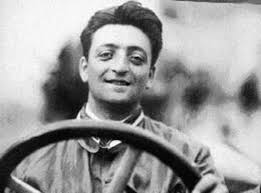
FERRARI
THE MAN BEHIND THE MYTH
There is no question that there is no other manufacturer that has created as much passion and excitement for a car as Ferrari. The story begins on February 18, 1898, in Modena, Italy at the hands of Enzo Anselmo Ferrari, who, without even knowing it, would in a few years be the founder of one of the most important, renowned and respected world brands of all time.
Perhaps many people do not know this, but in his youth “Il Commendatore”, as Ferrari was known, wanted to be an opera singer. Luckily for motor racing fans all over the world, he spent his youth listening to another kind of music, one which came from powerful racing cars. It was those years of watching and listening to car racing that shaped his desire to become a racing car driver.
The son of Alfredo Ferrari and Adalgisa Bisbini, and brother of Alfredino, he grew up in northern Italy in a hard-working, well-to-do family. Father and brother were recruited to intervene in the First World War: they died in 1916, when Enzo was just 18, from a flu epidemic. He had a different fate. The following year he was discharged from the army because of a severe pneumonia.
His mother considered him the black sheep of the Ferrari family. He disregarded his parents’ advice: he didn’t want to be an engineer, he studied mechanics. His devotion to racing found him in Bologna, on the Via Emilia circuit, when at the age of ten his father Alfredo took him to learn about the world of motor racing. With his father Alfredo and brother Alfredino deceased, and his mother Adalgisa in eternal mourning, he invested the family inheritance in the field of competition, earning in Modena his first nickname: “The Madman”.
Ferrari the man
A man who was an orphan, in bad health, unfaithful, a widower, the father of a son who died, the owner of a bombed-out factory, author of some celebrated phrases, the possessor of a Dantesque life. Through this series of unfortunate events, Enzo Ferrari gave his name to one of the most important automobile manufacturers.
The prosperity of his company hid the darkness of his personal history. Enzo Ferrari loved women and recognised his status as a “womaniser”: in 1945 Piero Ferrari was born, the result of an extramarital affair with his lover Lina Lardi. Tragedy struck him in 1956, when his son Dino, destined to be his successor, died at the age of 25 of muscular dystrophy. The black glasses were, from that day on, a sign of immutable mourning, attached to what was left of his life. He coped with the passing of his heir better than his wife, Laura, who mourned the death of her mentally disturbed son, leading to an irremediable separation with Enzo.
The misfortunes lasted until the year after Dino’s death. An accident of the Marquis Alfonso de Portago at 260 km/h on the Mille Miglia left eleven dead: the driver and ten spectators. Distraught, Enzo shut himself up in his house for seven days. “When he said goodbye to them before a competition, he hugged and kissed them as if it were the last time. I knew they were going to a race, but nobody could assure me they would come back,” he shared. He would hire aggressive, bold, daring, dignified drivers to take the same risks he took as a racing driver: he would fall in love with their competitive spirit.
The accumulation of misfortunes condemned him to live with a constant wave of bitterness. He confined himself to a house inside the Maranello factory. In 1977 he resigned as president of the company due to his delicate state of health. The following year his wife died. The lethargy in his life was extinguished on August 14, 1988. Despite having convulsed the automotive industry, he did not identify himself as a winner. His conscience was burdened by the death of his wife Laura, the loss of his son Dino, the destruction of his first factory and the deaths of his favourite drivers.
Enzo Ferrari was a man with fire in his blood. He imprinted that condition on his creations. The fire in Ferrari’s engines is indelible to his purposes. “I don’t know what the soul is like, but if it exists, engines should have one, because they complain, they get desperate, they rebel and behave like children who are being educated day by day.”

His son Dino was born in 1932, the result of a marriage to Laura Dominica. The birth of his first-born inspired him to abandon his career, a risky profession at that time.
This aspiration stayed alive even during the dangerous years of World War I, when hostilities ceased, Ferrari left the army in a delicate state of health, but he was in possession of a letter of recommendation for FIAT written by his commander.
Erroneously, as time was to prove, FIAT decided not to hire the young Enzo, although he secured a position as a test driver in a small company that converted Lancia light trucks. While he was working, a chance meeting with Ugo Sivocci laid the foundations for this duo to create the “Construzioni Meccaniche Nazionali” (CMN) to manufacture racing cars for the famous “Targa-Florio” race.
 This furtive entry into the world of the tracks gave Ferrari the opportunity to win a contract as a driver for Alfa Romeo. Thus, in 1920, Enzo Ferrari was positioned as a racing driver for Alfa Romeo, coincidentally alongside other legendary figures such as Antonio Ascari and Giuseppe Campari, who revealed Ferrari’s inferior skills behind the wheel. This event did not diminish his importance in the team but took him in a new direction. Because of his administrative skills and his talent for choosing the right man for a given task, he went on to plan and organize the team, although he occasionally still got behind the wheel.
This furtive entry into the world of the tracks gave Ferrari the opportunity to win a contract as a driver for Alfa Romeo. Thus, in 1920, Enzo Ferrari was positioned as a racing driver for Alfa Romeo, coincidentally alongside other legendary figures such as Antonio Ascari and Giuseppe Campari, who revealed Ferrari’s inferior skills behind the wheel. This event did not diminish his importance in the team but took him in a new direction. Because of his administrative skills and his talent for choosing the right man for a given task, he went on to plan and organize the team, although he occasionally still got behind the wheel.
 The legend grows, “Scuderia Ferrari” on the racetracks:
The legend grows, “Scuderia Ferrari” on the racetracks:
Ferrari achieved a lot for Alfa Romeo, but maybe, because he didn’t like working for others, in 1929 he made the crucial decision to found his own racing team, “Scuderia Ferrari”. We should not forget that those were the years of the Great Depression, and it was a risky decision. However, despite the weakness of the European economy, he managed to convince Alfa Romeo’s managers that he would save money if they let him organize and race with Alfas under the “Scuderia Ferrari” banner.
Enzo and “Scuderia Ferrari” became established in his hometown. Their idea was based on rich amateurs driving their own cars, while paying for services and repairs. This concept gradually faded away as the 1930s progressed: Alfa Romeo was happy to provide the state-of-the-art models, but naturally they wanted drivers with the skill to drive those machines. It was at this time that the famous “Prancing Horse” emblem appeared.
The “Cavallino Rampante”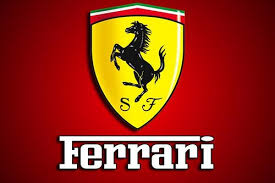
The “Cavallino Rampante” or “Prancing Horse” dates back to the Baracca family of Modena, this little horse had been part of their family coat of arms since the 18th century. During the First World War, Francesco Baracca painted the symbol on his plane. The Italian ace was shot down and died during the battle, and the story goes that in 1923 when Ferrari won a race, they gave him a piece of Baracca’s plane that showed the emblem.

Another version states that Ferrari’s brother was from the same squadron as Baracca, and when he too was killed in combat, the Countess of Baracca suggested that the steed’s emblem be used on the cars as a reminder. Whatever the story, the truth is that this symbol has become famous all over the world, although very few people know that the symbol was modified. The original horse had a droopy tail, and it was replaced by an upright tail to make it more dramatic and stronger.
The Second World War, a “ceasefire” in motoring

Although motor racing ceased during the war, development in Modena did not stop, the company developed a series of components as part of the Italian contribution in the global turmoil, and Enzo acquired a good number of highly qualified engineers. Despite the fact that the factory had been bombed a couple of times, Ferrari’s facilities were perfectly equipped to return to sports production once the war was over: it had a staff of 200, its financial position was strong, and Enzo had 20 years’ experience as a driver, builder and team leader.
The 1940s, the true foundation of the Ferrari Empire
In the years following the war, people everywhere were looking for new forms of entertainment, and motor racing was an exciting sport. Although many manufacturers were concentrating on producing passenger cars and commercial vehicles for mass production, Enzo Ferrari, who was in a position to do so, remained adamant that success on the track would ensure sales at the showrooms. Therefore, 1947 is the year that really begins Ferrari’s history as a manufacturer of racing and street cars, the very cars that would make him a true legend in the years to come. It is worth noting that it is at this point that the Ferraris were first manufactured in red and named after their maker.
“Ferrari” by name

The first Ferrari to bear Don Enzo’s surname was the 125, a 1947 single-seater model that was used both on the track and on the road, with a 1496 cm³ V12 engine that delivered 72 HP. At the 1948 Turin Motor Show, the Tipo 166 was unveiled, which is recognized as the first “street” Ferrari, equipped with a V12 engine derived from the previous one, but thanks to an increase in displacement (1901cm³) it was able to produce 125 HP; and was presented as a coupe with some passenger space in the rear.
The Fifties
Until 1952 Ferrari produced around 200 vehicles a year, and in the next decade this number would grow for three reasons: the growing European market, the new North American market and the introduction of the 250 line, created for both markets.

The American market was very different from the European market: the latter penalized through taxation cars with engines above 3 litres of displacement, for that reason Ferrari introduced two new Gran Turismo at the Paris Motor Show in 1953, the 250 Europe of 2963 cm³ and the 375 America of 4522 cm³, the largest Ferrari engine until then. The 250 line was a success for the factory and confirmed “Pininfarina” as the designer. It also marked an important step forward in competition and was the platform for one of the most charismatic and attractive sports cars of all: the 250 GTO.
The first mid-engine Ferrari
Given its years of experience in developing and building cars, it is surprising that Ferrari did not create a mid-engine car until the late 1960s. But an unspoken rule at Ferrari was that mechanical specifications should prove useful on the track beyond any possible doubt and then be offered to the public. That was the reason why Ferrari, whilst having so much experience building cars with front and rear engines, took so long to build a mid-engine car, thus falling behind its Maserati and Lamborghini competitors.

Thus, the first mid-engine car produced by Ferrari was driven by a commercial need rather than a technical need. Enzo had long thought of a smaller, more economical Ferrari to rival the two-litre Porsche models. That “son” of Ferrari, actually named after his son Dino, was presented at the 1967 Turin Motor Show in the 206 GT.
A year later it began production and this was perhaps one of the most scandalous Ferraris, because many argued that a “real” Ferrari could not have a central engine, and furthermore the Prancing Horse emblem had been replaced by a shield that simply said “Dino”. It was clear that this model was intended to compete with the Porsche 911. The design proved to be versatile, allowing both hard-top and Spyder (convertible).
In 1984 after many vicissitudes in the following decades, it was felt that 512 BB was a little outdated, so Ferrari announced that they would be producing a new design to replace it and once again they produced a supercar that due to its design, beauty and performance was at the forefront of all: The Testarossa. It was perhaps the most impressive design of the time, a model that was massively influential in the minds of all buyers. If there is a recognizable Ferrari for the vast majority of the public, that is the 1984 Testarossa, and the most universal example of the model is none other than the one used in the 1980s series ‘Miami Vice’ starring by Don Johnson.
The end of the 80s, the 40th anniversary and the death of Enzo Ferrari

1987 marked the 40th anniversary of the creation of the first “street” Ferrari, and to celebrate it the factory produced one of the most impressive cars in the world: the F40, a car that was described by Enzo himself as “the sum of all Ferrari’s efforts over the years”. The goal was simple: to produce the fastest “street” Ferrari ever created and take the initiative away from its long-time competitor, Lamborghini.
No doubt this is a fitting tribute to 40 years of Ferrari sports cars, and it is the last car Enzo Ferrari saw before his death on the 14th of August 1988 at the age of 90. However, it is not an epitaph, but rather a celebration of everything that “Il Commendatore” believed in and created throughout his life.

But like every man of legend, he also had his weaknesses …
Fiamma Breschi, the Ferrari spy lady – great secret love of the team leader
The story of Fiamma Breschi (Florence, 1934) and the Ferrari name is a legend woven of mystery, passion and tragedy around the formula 1. At the age of 17, Fiamma Breschi, an attractive Florentine who had made her debut in the cinema, met the driver Luigi Musso, an emerging star of motor racing and a symbol of post-war Italy. The attraction between the two was overwhelming. The driver, ten years older than her, married with a daughter, abandoned his family in the face of the scandal of a still provincial country that had not recovered from the “adultery” of Ingrid Bergman and Roberto Rossellini.
Fiamma Breschi entered the exclusive club of the wives and partners of the Formula 1 drivers who live in the front line of the car circus. Her class and style stood out, and photographers never missed the chance to photograph her in Monte Carlo or Monza with Musso, together they formed one of the most attractive couples on the circuit. Musso, who had taken his first steps with Maserati, signed up with Ferrari; Il Cavaliere saw in him the promise of a great Italian figure to fill the void left by Castellotti’s death. Within Ferrari the rivalry between the Roman driver and the Britons Peter Collins and Mike Hawthorn soon grew tense.
The 1958 season introduced Musso as the only Italian ambassador for Ferrari in international competitions. The driver’s problems with his British colleagues were compounded by his addiction to gambling, which caused him to run up huge debts and squander his fortune. The French Grand Prix in Reims, a competition sponsored by the champagne company and with a juicy reward of 10 million lire, the largest prize in the formula 1, could have been a lifeline for Musso and his financial problems, but the race ended in tragedy with the death of the Italian driver, amidst suspicions that were never dispelled about a possible reckless move by his partner, the Englishman Hawthorn. Fiamma Breschi visited Musso in the hospital, where he was in a coma, and on returning to the hotel was told of the driver’s death. She tried to throw herself from the window of her room, which was avoided by her companions, Beba, Fangio’s wife, and Lulu Trintignant, wife of the pilot Maurice Trintignant.
An ‘annus horribilis’

Decades later Fiamma Breschi would relive those moments in her memoirs, Il mio Ferrari (Musio, 1998), her personal settling of scores with her husband’s two British teammates. Closing the circle of tragedy, that same 1958 Collins and Hawthorn died in two car accidents. In an attempt to avert the annus horribilis of his team, Enzo Ferrari ordered the destruction of all the surviving single-seaters from that infernal year. For Fiamma Breschi, a wound was healing.
Months after the tragedy Fiamma Breschi received a letter from Enzo Ferrari offering her friendship and inviting her to Maranello, the heart of the car brand. An intense correspondence and telephone communication marked an increasingly close relationship between the two. Il Commendatore turned her into a kind of image consultant who brought to the brand the female vision of a deeply masculine world. Ferrari himself, “a man with the look of a peasant”, as Fiamma describes him in her memoirs, transforms his style, swapping his rigorous black and white ties for colourful Gucci pieces that Fiammale brings from Florence. The team’s new style advisor also carried out “spy” missions for Il Cavaliere, passing on reports of what was going on at the back of the circuits.
The aspersions of a secret relationship between the two would not be lifted until the death of Enzo Ferrari in 1988; a bond that Fiamma always denied, describing her relationship with him as a platonic love. Months before his death, Ferrari asks her to marry him, but in the life of “the lady of the Ferrari” there is only room for one great love: Luigi Musso. The man she had known as a teenager and who remained present every day of her life and in her memories. Fiamma Breschi died at the age of 81 on 20 November 2015.

Approaching 1990, Ferrari surprises once again
Despite Enzo’s death, the brand had to look forward. Now under the FIAT umbrella, the factory had to face the future of environmental regulations, congested roads and an economic climate with many ups and downs that seemed to signal the extinction of the supercars. However, this was not the case. While the Lamborghini people continued to produce new models, more competitors like Bugatti and Honda came to market. That was the time when more than ever Ferrari had to look deep inside itself and develop new cars. The first move was to replace the outdated 328 with the 348 Tb, a model that looked like a small Testarossa, but was just as fast. It had a 3.4 litre V8 engine that developed 300HP, and moreover this model had all the charisma expected from a Ferrari. It was such a success that the waiting lists were five years for a delivery.

For Ferrari, the latter years of the 20th century have been very different from those in which Enzo began. Environmental and economic factors have seriously affected car production throughout the world, so what chance does a dream manufacturer have? However, it seems that there will always be room for a car with the “Prancing Horse” on the bonnet. A Ferrari is passion, and as long as emotion continues to control our lives, there will always be room for these Italian masterpieces.
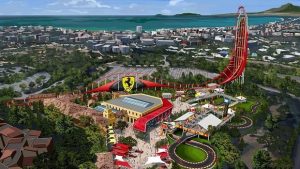 For those who are passionate about cars and do not want to be left with the desire to one day live the Ferrari experience, in Port Aventura in the province of Tarragona, the Ferrari Land theme park, can fulfil a dream. It is the second car theme park after the one created in Abu Dhabi. Among many of the attractions are the iconic buildings of Maranello, Ferrari’s hometown.
For those who are passionate about cars and do not want to be left with the desire to one day live the Ferrari experience, in Port Aventura in the province of Tarragona, the Ferrari Land theme park, can fulfil a dream. It is the second car theme park after the one created in Abu Dhabi. Among many of the attractions are the iconic buildings of Maranello, Ferrari’s hometown.
There is always someone capricious who can afford a real Ferrari. We recommend that you go to the official Santogal Automobile dealer. You will receive excellent and professional treatment and they also have a very interesting second-hand market.

BIBLIOGRAPHY.- from electronic sources
Bodegas Valduero
La historia de Ferrari, según el lente de su fundador
Los “primeros” de Ferrari: ¿Cuáles han sido los Ferrari pioneros dentro de la propia marca?
La verdadera historia del Ferrari Testarossa blanco de Miami Vice


